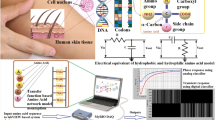Abstract
Melanoma is a form of cancer that begins in melanocytes. The occurrence of melanoma continues to rise across the world and current therapeutic options are of limited benefit. Researchers are studying the genetic changes in skin tissue linked to a life-threatening melanoma through SNP genotyping, Expression microarrays, RNA interference etc. In the spectrum of disease, identification and characterization of melanoma proteins is also very important task. In the present study, effort has been made to identify the melanoma protein through Support Vector Machine. A positive dataset has been prepared through databases and literature whereas negative dataset consist of core metabolic proteins. Total 420 compositional properties of amino acid dipeptide and multiplet frequencies have been used to develop SVM model classifier. Average performance of models varies from 0.65-0.80 Mathew’s correlation coefficient values and 91.56% accuracy has been achieved through random data set.
Access this chapter
Tax calculation will be finalised at checkout
Purchases are for personal use only
Preview
Unable to display preview. Download preview PDF.
Similar content being viewed by others
References
Owens, D.M., Watt, F.M.: Contribution of stem cells and differentiated cells to epidermal tumours. Nat. Rev. Cancer 3, 444–451 (2003)
Berwick, M., Erdei, E., Hay, J.: Melanoma epidemiology and public health. Dermatol. Clin. 27, 205–214 (2009)
Greenlee, R.T., Murray, T., Bolden, S., Wingo, P.A.: Cancer statistics. CA Cancer J. Clin. 50, 7–33 (2000)
Sanjiv, S., Agarwala, M.D.: Metastatic melanoma: an AJCC review. Community Oncology 5(8), 441–445 (2008)
Jemal, A., Siegel, R., Ward, E., Hao, Y., Xu, J., Thun, M.J.: Cancer statistics. CA Cancer J. Clin. 59, 225–249 (2009)
Hartleb, J., Arndt, R.: Cysteine and indole derivatives as markers for malignant melanoma. Journal of chromatography B 764, 409–443 (2001)
Wang, S., Setlow, R., Berwick, M., Polsky, D., Marghoob, A., Kopf, A., Bart, R.: Ultraviolet A and melanoma: a review. J. Am. Acad. Dermatol. 44(5), 837–846 (2001)
Elwood, J.M., Gallagher, R.P.: The first signs and symptoms of melanoma: a population-based study. Pigment Cell Res. 9, 118–130 (1988)
Oliveria, S.A., Christos, P.J., Halpern, A.C., Fine, J.A., Barnhill, R.L., Berwick, M.: Patient knowledge, awareness, and delay in seeking medical attention for malignant melanoma. Journal of Clinical Epidemiology 52(11), 1111–1116 (1999)
Kecman, V.: Support Vector Machines – An Introduction. Stud. Fuzz. 177, 1–47 (2005)
Bairoch, A., Apweiler, R.: The SWISS-PROT protein sequence database and its supplement TrEMBL in 2000. Nucleic Acid Res. 28(1), 45–48 (2002)
Ansari, F.A., Naveen, K., Subramanyam, M.B., Gnanamani, M., Ramachandran, S.: MAAP: Malarial adhesins and adhesin-like proteins predictor. Proteins 70, 659–666 (2008)
Joachims, T.: Making large-scale SVM learning particle. In: Scholkopf, B., Burges, C., Smola, A. (eds.) Advances in Kernel Methods Support Vector Learning, pp. 42–56. MIT Press, Cambridge (1999)
Kushwaha, S.K., Shakya, M.: Neural Network: A Machine Learning Technique for Tertiary Structure Prediction of Proteins from Peptide Sequences, act. In: 2009 International Conference on Advances in Computing, Control, and Telecommunication Technologies, pp. 98–101 (2009)
Bhasin, M., Raghava, G.P.S.: Analysis and prediction of affinity of TAP binding peptides using cascade SVM. Protein Sci. 13, 596–607 (2004)
Matthews, B.W.: Comparison of the predicted and observed secondary structure of T4 phage lysozyme. Biochim. Biophys. Acta 405, 442–451 (1975)
Author information
Authors and Affiliations
Editor information
Editors and Affiliations
Rights and permissions
Copyright information
© 2010 Springer-Verlag Berlin Heidelberg
About this paper
Cite this paper
Rathore, B., Kushwaha, S.K., Shakya, M. (2010). Identification of Melanoma (Skin Cancer) Proteins through Support Vector Machine. In: Das, V.V., Vijaykumar, R. (eds) Information and Communication Technologies. ICT 2010. Communications in Computer and Information Science, vol 101. Springer, Berlin, Heidelberg. https://doi.org/10.1007/978-3-642-15766-0_97
Download citation
DOI: https://doi.org/10.1007/978-3-642-15766-0_97
Publisher Name: Springer, Berlin, Heidelberg
Print ISBN: 978-3-642-15765-3
Online ISBN: 978-3-642-15766-0
eBook Packages: Computer ScienceComputer Science (R0)




